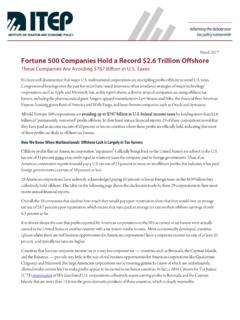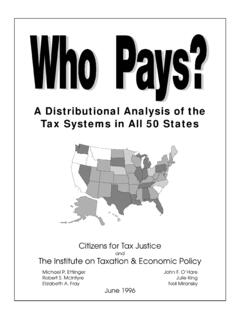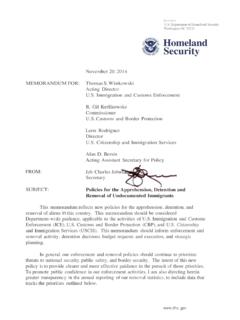Transcription of State & Local Tax Contributions of Young Undocumented ...
1 State & Local Tax Contributions of Young Undocumented Immigrants Institute on Taxation & Economic Policy April 2017. Misha E. Hill Meg Wiehe About The Institute on Taxation & Economic Policy The Institute on Taxation and Economic Policy (ITEP) is a non-profit, non-partisan 501 (c) 3 organization that produces timely, accessible, and sound analyses on federal, State , and Local tax policy issues. ITEP's research helps inform policy makers, advocates, the media and general public about the fairness, adequacy, and sustainability of existing tax structures and how proposed tax changes would impact revenues and taxpayers across the income spectrum. Acknowledgments ITEP extends special thanks to David Dyssegaard Kallick at the Fiscal Policy Institute, Erica Williams at the Center on Budget and Policy Priorities, Jeanne Batalova at the Migration Policy Institute, and Wesley Tharpe at the Georgia Budget and Policy Institute for their guidance on this report.
2 THE INSTITUTE ON TAXATION AND ECONOMIC POLICY (ITEP). 1616 P. Street NW, Suite 200 Washington, DC 20036 Introduction What is DACA? The Trump administration's immigration policies have Deferred Action for Childhood Arrivals provides temporary deferral from deportation and work authorization. Individuals broken apart families and removed established members of must apply for DACA status through Citizenship and communities. The administration's disregard for the Immigration Services. Approved individuals maintain their Contributions of immigrants, regardless of their legal status, is status for two years and must apply to renew their eligibility. of real concern for Young immigrants whose parents brought To qualify for DACA an individual must: them to the United States as children.
3 Many of those Young Be between the ages of 15 and 30. immigrants qualify for deferred deportation action and legal work authorization under Deferred Action for Childhood Have arrived in the prior to the age of 16. Arrivals (DACA), a 2012 executive order under President Barack Obama. Have continuously resided in the for at least five years prior to their application for deferred action While it remains unclear what actions, if any, President Trump . will take to amend DACA, the policy guidance the president Be enrolled in an approved education course, have has given to federal agencies has resulted in detentions and completed high school or its equivalency, or have been honorably discharged from military service deportations of individuals reportedly eligible for deferred.
4 Action. The ambiguity of the Trump Administration's Not have been convicted of a felony, significant statements and actions relating to the DACA program makes misdemeanor, three or more misdemeanors, or otherwise it essential that clear and accurate data about the DACA pose a threat to public safety or national security . population is available.. Note: See DACA at Four and DACA at the Two-Year Mark from the More than million out of the 11 million Undocumented Migration Policy Institute for more detailed information. immigrants living in the United States are eligible for DACA. As of September 2016, more than 852,000 individuals were enrolled in the program.
5 1 DACA offers eligible teenagers and Young adults who were brought to the United States as children outside of their control temporary deferral from deportation and legal work authorization. 2. DACA enrollment has helped Young immigrants become more engaged in their communities. A national survey of DACA enrollees in 2016 found that more than 40 percent of respondents secured their first job after enrollment in DACA, and more than 60 percent landed a job with better pay. DACA enrollment also allowed 60 percent of respondents to pursue educational opportunities that were previously unavailable to them. The Young immigrants enrolled in DACA work in diverse industries, including educational and health services, wholesale and retail trade, and professional and business services.
6 The million Young immigrants eligible for deferred action contribute tax dollars to communities that help pay for schools, public infrastructure, and other services. Their Contributions could be increased by taking steps to ensure that all individuals eligible for deferred action are enrolled, or even by offering a path to citizenship. Conversely, stripping their temporary lawful status or deporting them would decrease their tax Contributions and deprive our country of a dedicated and diverse generation. Institute on Taxation and Economic Policy 2. An ITEP report from March 2017 found the 11 million Undocumented immigrants living and working in the United States contribute more than $ billion in State and Local taxes.
7 3 This report specifically examines the State and Local tax Contributions of Undocumented immigrants who are currently enrolled or immediately eligible for DACA and the fiscal implications of various policy changes. The report includes information on the national impact (Table 1) and provides a State -by- State breakdown (Appendix 1). Key Findings The million Young Undocumented immigrants enrolled or immediately eligible for DACA contribute an estimated $2 billion a year in State and Local taxes. 4 This includes personal income, property, and sales and excise taxes. DACA-eligible individuals pay on average percent of their income in State and Local taxes. Their effective tax rate is higher than the average rate paid by the top 1% of taxpayers in State and Local taxes of just percent and is on par with the average rate paid of percent paid by the middle 20 percent of taxpayers.
8 5. Continuing DACA and ensuring all who are eligible for the program are enrolled would increase estimated State and Local revenue by $425 million, bringing the total contribution to $ billion, and increasing the effective tax rate for those enrolled to 9 percent. Replacing DACA with a path to citizenship could provide nearly $505 million in additional State and Local taxes, increasing total Contributions to at least $ billion a year. Repealing the temporary legal status and work authorizations permitted by DACA would reduce estimated State and Local revenues by nearly $800 million, and drop the total Contributions to just over $ billion annually. Every State benefits from the economic Contributions of the Young immigrants eligible for DACA (see Appendices 1 and 2).
9 For example, the 379,000 Young immigrants living in California are contributing more than $534 million to the golden State while the 2,000 immigrants in our nation's capital contribute $ million to the District. Likewise, every State stands to lose considerable revenue if we do not maintain the protections and opportunities DACA has allowed. Institute on Taxation and Economic Policy 3. How federal policy changes in the treatment of Young immigrants affect State and Local revenues Questions have frequently been raised about the taxes paid by Undocumented immigrants. Everyone living and working in the contributes to State and Local taxes, regardless of their immigration status.
10 We all pay sales and excise taxes when we purchase goods and services such as clothing or gasoline. We all pay property taxes either directly for our homes or indirectly as renters. As ITEP's March report demonstrated, about half of Undocumented immigrants file income tax returns. They do this using Individual Taxpayer Identification Numbers (ITINs) in the absence of having valid Social Security numbers. Because DACA provides Young immigrants with work authorization, recipients are subject to the same State and Local personal income tax laws as all lawfully present workers. DACA recipients do have (temporary). Social Security numbers. The tax revenues generated by DACA recipients are further boosted by the fact that DACA status boosts employment rates and wages.










